Abstract
Intraperitoneal injection of zymosan (1 mg in 0.5 ml saline) in mice induces a transient writhing response accompanied by the synthesis of small amounts of prostaglandin E2(PGE2, less than 2 ng) and larger amounts of PGI2 (200 ng per mouse), measured as its non-enzymatic breakdown product, 6-keto-PGF1 alpha. Although both centrally-acting analgesics (morphine, clonidine) and prostaglandin biosynthesis inhibitors (aspirin, indomethacin, ibuprofen) blocked the writhing response to intraperitoneal injection of zymosan, only the latter reduced prostaglandin levels in the peritoneal cavity. The writhing response correlated equally well with PGE2 levels and 6-keto-PGF1 alpha levels when data from mice treated with centrally-acting analgesics were excluded. However, intraperitoneal injection of PGI2, but not PGE2, reversed the analgesia induced by indomethacin in zymosan-injected mice. Centrally-acting agents, but not ibuprofen, blocked the ability of PGI2 to reverse the analgesic activity of indomethacin. PGI2 (2 micrograms per mouse), injected intraperitoneally in otherwise untreated mice, induced writhing. These data indicate that PGI2 is the prostaglandin involved in mediation of the writhing response to zymosan and that prostaglandin biosynthesis inhibitors, but not centrally-acting analgesics, exert their analgesic activity by reducing the peritoneal level of PGI2. It is possible that PGI2 may have the ability to stimulate pain receptors directly in the mouse peritoneal cavity, in addition to its previously recognized ability to sensitize pain receptors to other pain-producing stimuli.
Full text
PDF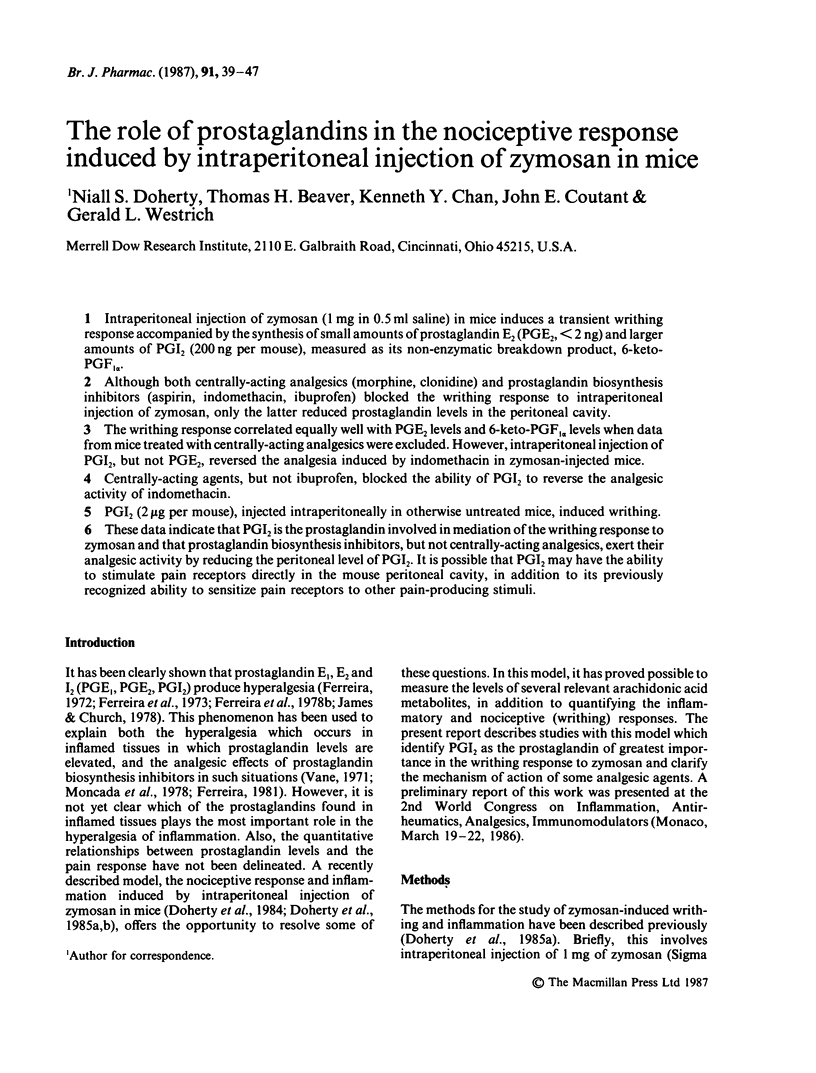
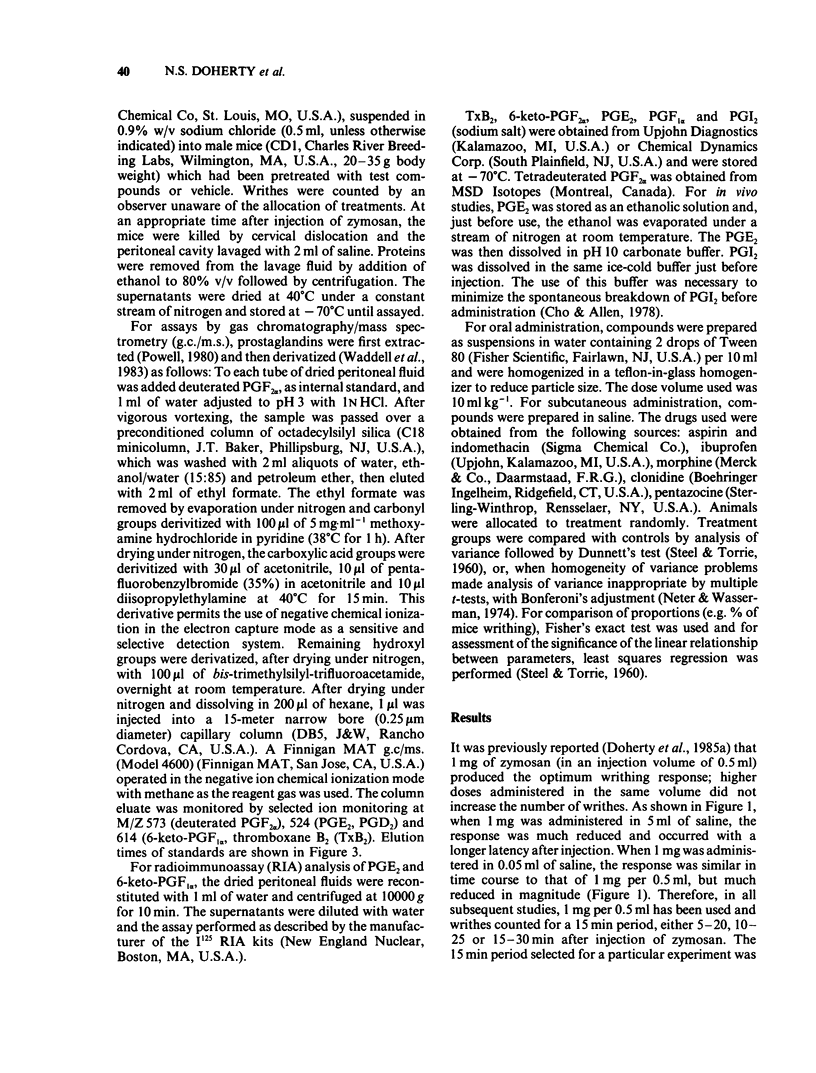
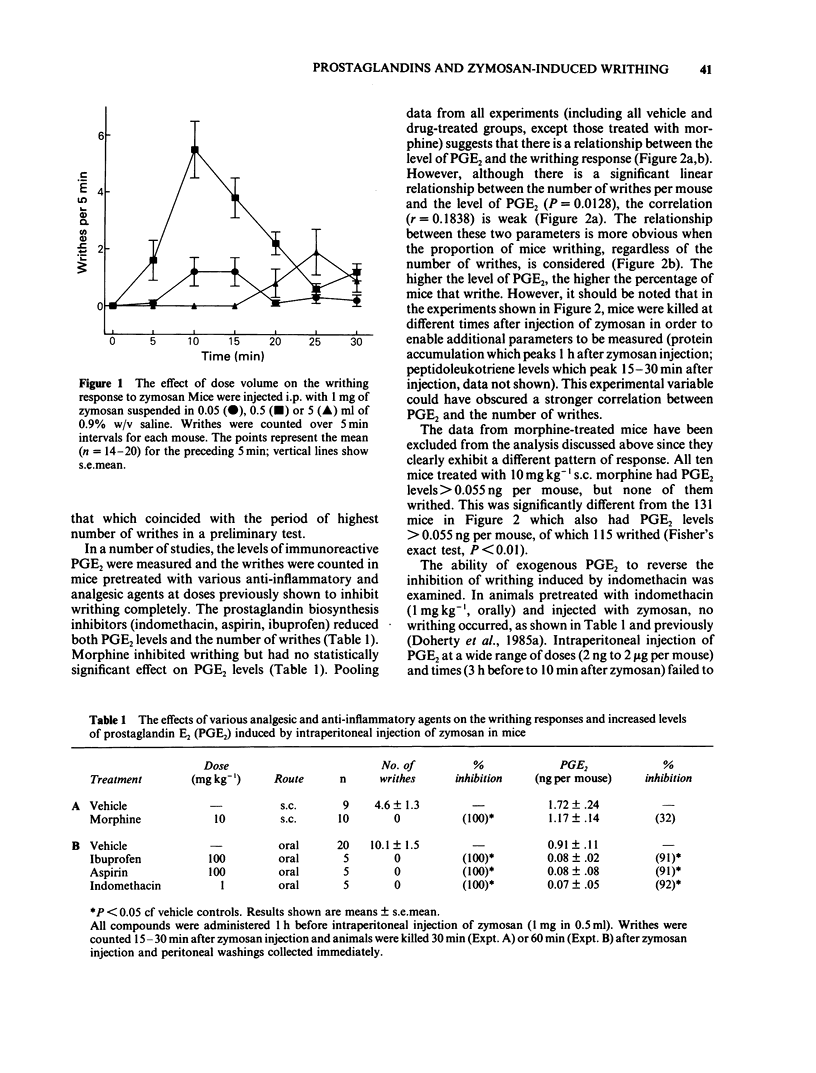
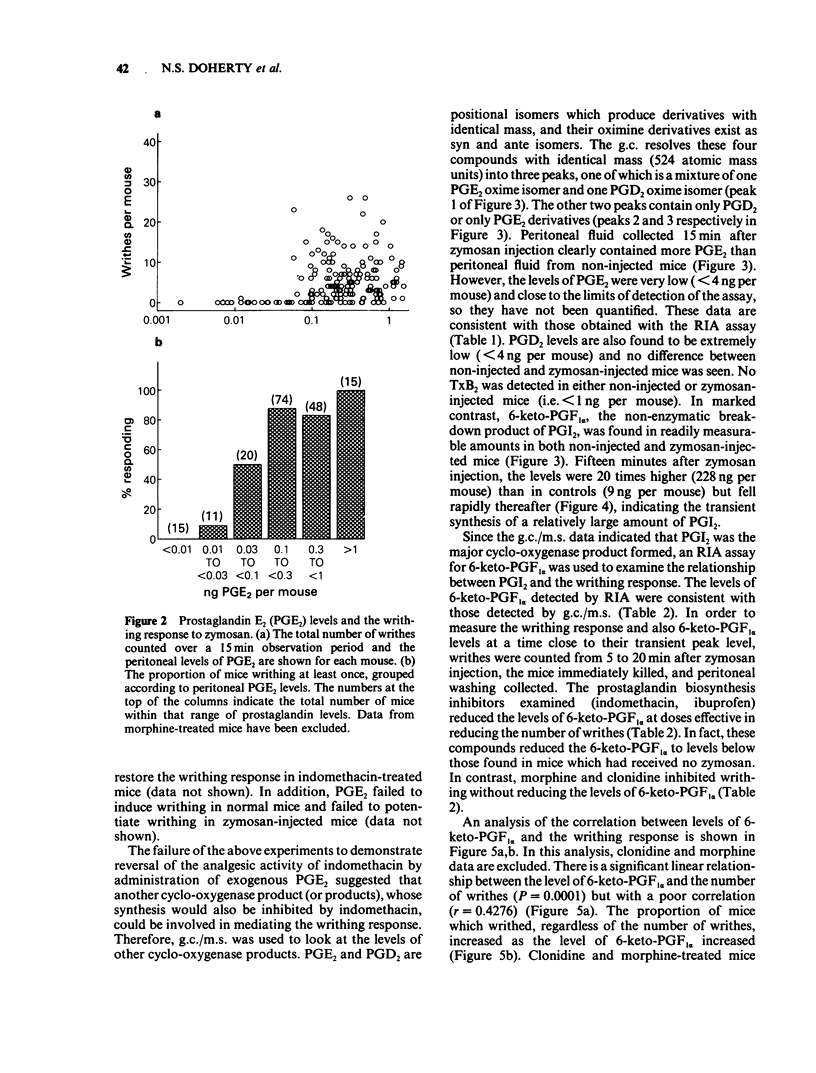
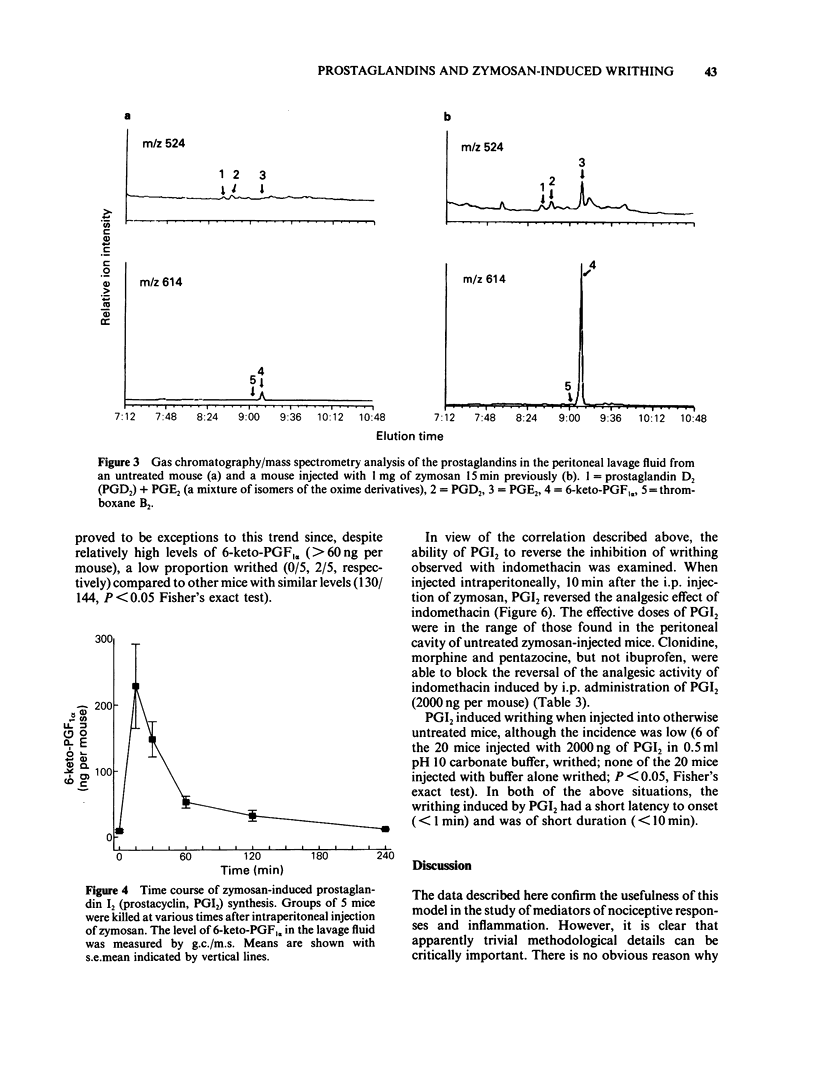
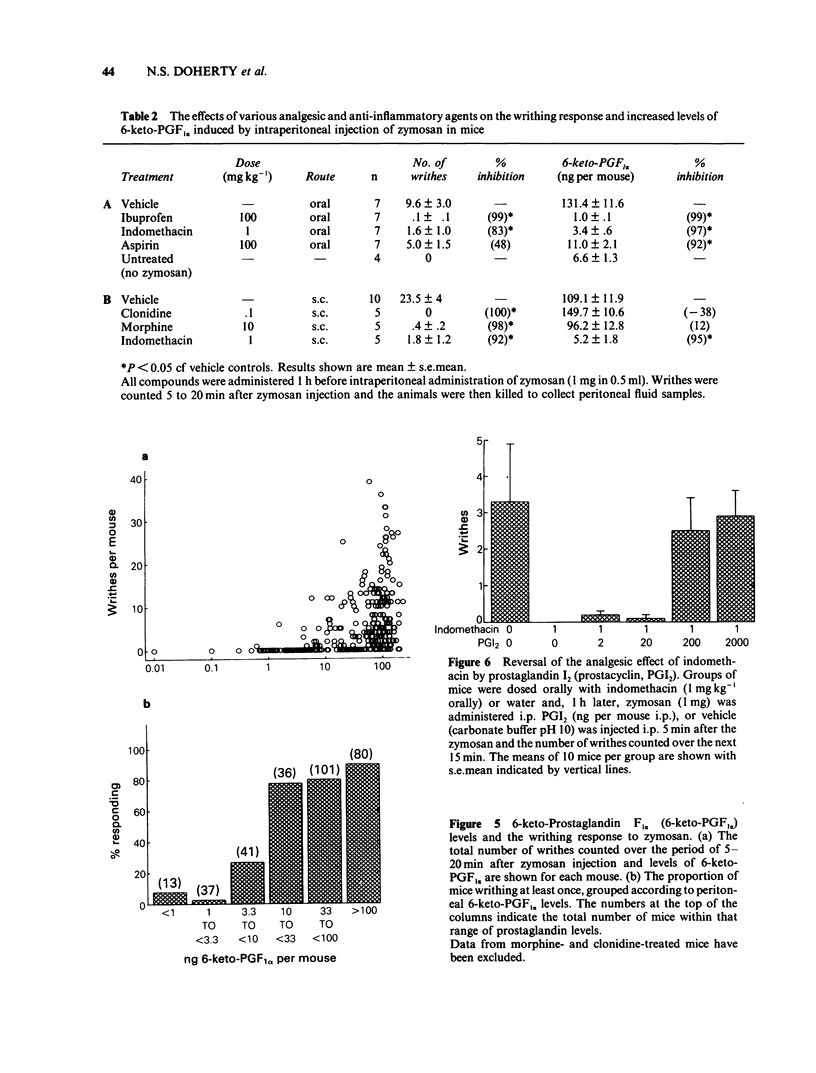
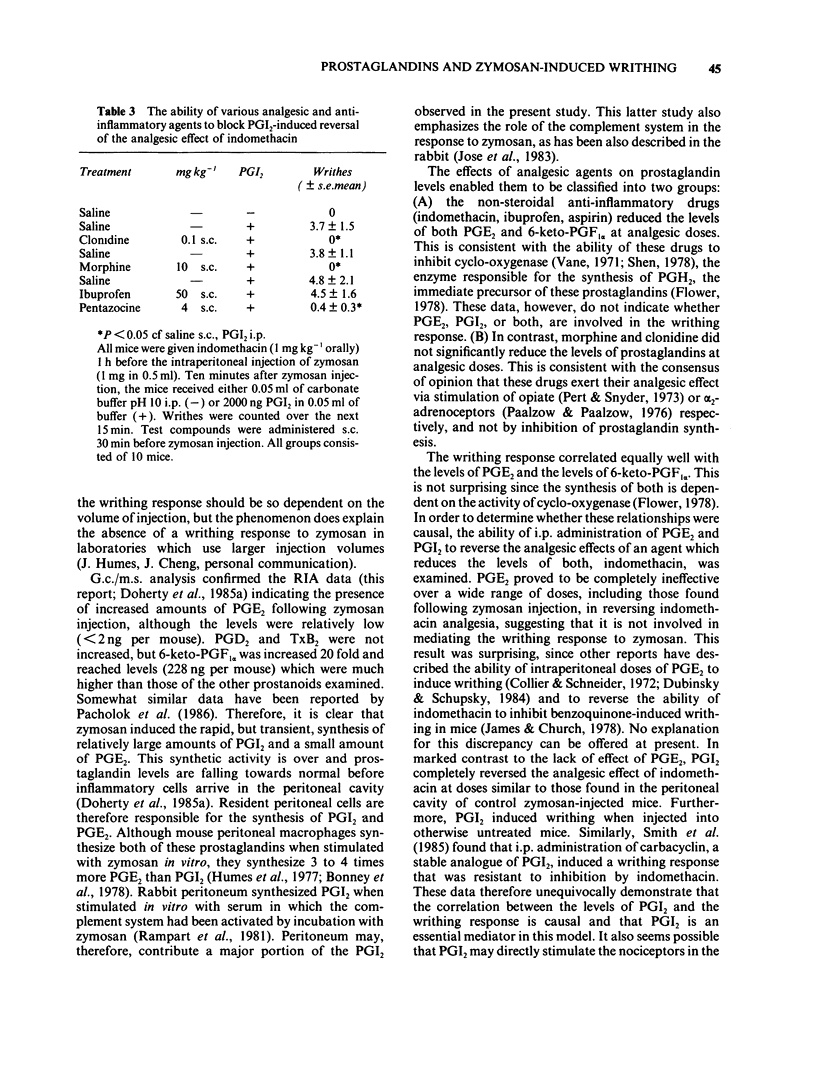
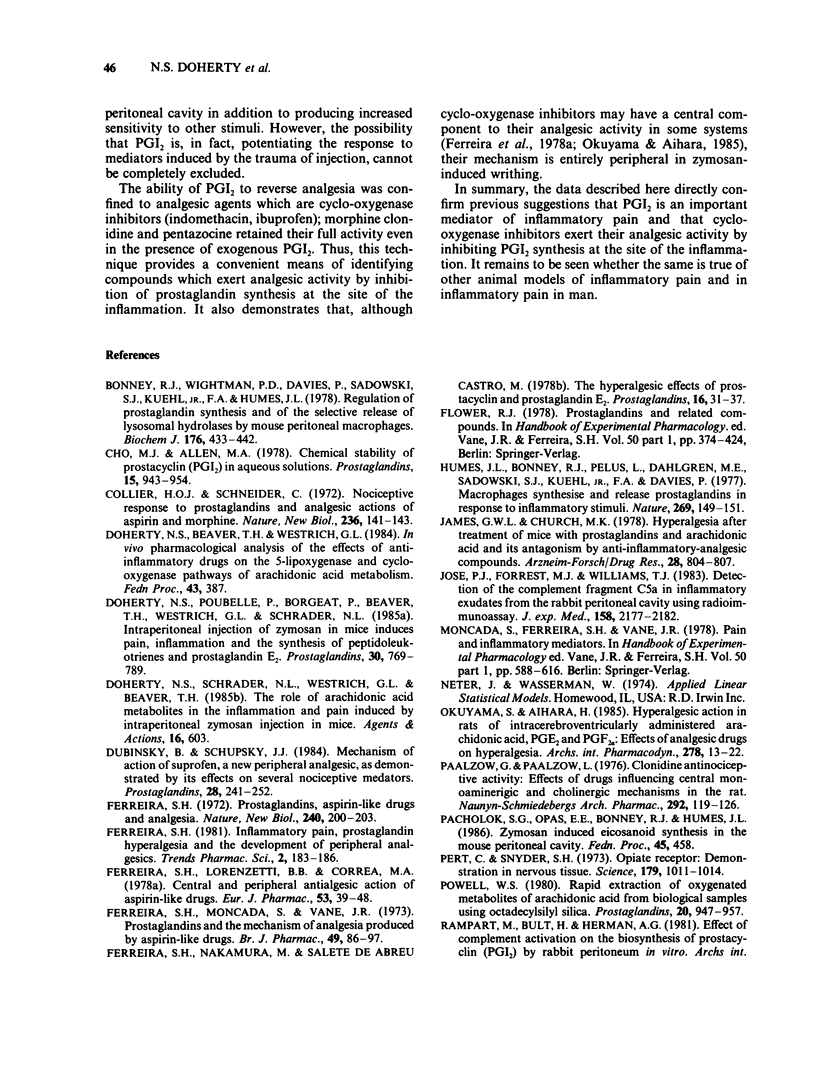

Selected References
These references are in PubMed. This may not be the complete list of references from this article.
- Bonney R. J., Wightman P. D., Davies P., Sadowski S. J., Kuehl F. A., Jr, Humes J. L. Regulation of prostaglandin synthesis and of the selective release of lysosomal hydrolases by mouse peritoneal macrophages. Biochem J. 1978 Nov 15;176(2):433–442. doi: 10.1042/bj1760433. [DOI] [PMC free article] [PubMed] [Google Scholar]
- Cho M. J., Allen M. A. Chemical stability of prostacyclin (PGI2) in aqueous solutions. Prostaglandins. 1978 Jun;15(6):943–954. doi: 10.1016/0090-6980(78)90037-0. [DOI] [PubMed] [Google Scholar]
- Collier H. O., Schneider C. Nociceptive response to prostaglandins and analgesic actions of aspirin and morphine. Nat New Biol. 1972 Apr 5;236(66):141–143. doi: 10.1038/newbio236141a0. [DOI] [PubMed] [Google Scholar]
- Doherty N. S., Poubelle P., Borgeat P., Beaver T. H., Westrich G. L., Schrader N. L. Intraperitoneal injection of zymosan in mice induces pain, inflammation and the synthesis of peptidoleukotrienes and prostaglandin E2. Prostaglandins. 1985 Nov;30(5):769–789. doi: 10.1016/0090-6980(85)90006-1. [DOI] [PubMed] [Google Scholar]
- Dubinsky B., Schupsky J. J. Mechanism of action of suprofen, a new peripheral analgesic, as demonstrated by its effects on several nociceptive mediators. Prostaglandins. 1984 Aug;28(2):241–252. doi: 10.1016/0090-6980(84)90060-1. [DOI] [PubMed] [Google Scholar]
- Ferreira S. H., Lorenzetti B. B., Corrêa F. M. Central and peripheral antialgesic action of aspirin-like drugs. Eur J Pharmacol. 1978 Dec 15;53(1):39–48. doi: 10.1016/0014-2999(78)90265-0. [DOI] [PubMed] [Google Scholar]
- Ferreira S. H., Moncada S., Vane J. R. Prostaglandins and the mechanism of analgesia produced by aspirin-like drugs. Br J Pharmacol. 1973 Sep;49(1):86–97. doi: 10.1111/j.1476-5381.1973.tb08270.x. [DOI] [PMC free article] [PubMed] [Google Scholar]
- Ferreira S. H., Nakamura M., de Abreu Castro M. S. The hyperalgesic effects of prostacyclin and prostaglandin E2. Prostaglandins. 1978 Jul;16(1):31–37. doi: 10.1016/0090-6980(78)90199-5. [DOI] [PubMed] [Google Scholar]
- Ferreira S. H. Prostaglandins, aspirin-like drugs and analgesia. Nat New Biol. 1972 Dec 13;240(102):200–203. doi: 10.1038/newbio240200a0. [DOI] [PubMed] [Google Scholar]
- Humes J. L., Bonney R. J., Pelus L., Dahlgren M. E., Sadowski S. J., Kuehl F. A., Jr, Davies P. Macrophages synthesis and release prostaglandins in response to inflammatory stimuli. Nature. 1977 Sep 8;269(5624):149–151. doi: 10.1038/269149a0. [DOI] [PubMed] [Google Scholar]
- James G. W., Church M. K. Hyperalgesia after treatment of mice with prostaglandins and arachidonic acid and its antagonism by anti-inflammatory-analgesic compounds. Arzneimittelforschung. 1978;28(5):804–807. [PubMed] [Google Scholar]
- Jose P. J., Forrest M. J., Williams T. J. Detection of the complement fragment C5a in inflammatory exudates from the rabbit peritoneal cavity using radioimmunoassay. J Exp Med. 1983 Dec 1;158(6):2177–2182. doi: 10.1084/jem.158.6.2177. [DOI] [PMC free article] [PubMed] [Google Scholar]
- Okuyama S., Aihara H. Hyperalgesic action in rats of intracerebroventricularly administered arachidonic acid, PG E2 and PG F2 alpha: effects of analgesic drugs on hyperalgesia. Arch Int Pharmacodyn Ther. 1985 Nov;278(1):13–22. [PubMed] [Google Scholar]
- Paalzow G., Paalzow L. Clonidine antinociceptive activity: effects of drugs influencing central monoaminergic and cholinergic mechanisms in the rat. Naunyn Schmiedebergs Arch Pharmacol. 1976;292(2):119–126. doi: 10.1007/BF00498581. [DOI] [PubMed] [Google Scholar]
- Pert C. B., Snyder S. H. Opiate receptor: demonstration in nervous tissue. Science. 1973 Mar 9;179(4077):1011–1014. doi: 10.1126/science.179.4077.1011. [DOI] [PubMed] [Google Scholar]
- Powell W. S. Rapid extraction of oxygenated metabolites of arachidonic acid from biological samples using octadecylsilyl silica. Prostaglandins. 1980 Nov;20(5):947–957. doi: 10.1016/0090-6980(80)90144-6. [DOI] [PubMed] [Google Scholar]
- Smith T. W., Follenfant R. L., Ferreira S. H. Antinociceptive models displaying peripheral opioid activity. Int J Tissue React. 1985;7(1):61–67. [PubMed] [Google Scholar]
- Vane J. R. Inhibition of prostaglandin synthesis as a mechanism of action for aspirin-like drugs. Nat New Biol. 1971 Jun 23;231(25):232–235. doi: 10.1038/newbio231232a0. [DOI] [PubMed] [Google Scholar]


